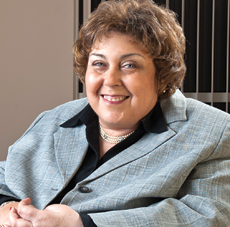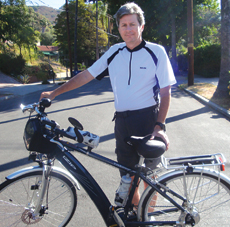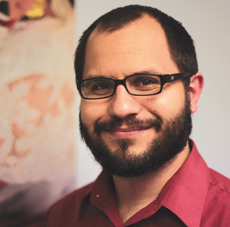
Photo:National MS Society
Nicole Lemelle
Her New Normals
When Nicole Lemelle, 36, was diagnosed with MS in 2000, she discovered what it meant to lose much of what she thought essential to her own identity. She was diagnosed while in nursing school, after bouts of optic neuritis (optic nerve inflammation). But that didn't stop her from getting her degree.
However, when her MS flared in 2009, she was forced to give up nursing. Not only that, she had to return to Louisiana and live with her parents for a year until her husband Tommy could leave Maryland. "It was a big shift," Nicole recalls. "My identity was wrapped up in my job. And I'm married — I was supposed to be with my husband!"
She asks, "Who do you become when the major pieces of yourself are gone? I couldn't drive. I couldn't work."
Nicole had always enjoyed writing, but had been too busy to do it. "I was reunited with writing when my husband and I lived in different states," she says. "It was my outlet for grief."
She began a blog she called "My New Normals." "My new normal was everything MS dictated," she says. She added the "s" on the end because what is normal keeps changing. Writing her blog helped her realize that MS. couldn't touch her core: "Who I am internally — it doesn't matter that I can't walk."
While she is physically weaker than a year or two ago, "emotionally I'm stronger, more resilient and tenacious than ever — If I stop doing what I love, I feel MS is winning. I've learned so many skills, and one is to use humor to get through it."

Photo:National MS Society
Iris Young
Working With MS
If Iris Young had listened to the neurologist who diagnosed her MS in 1988, after eight years of symptoms, she would have "gone home and had a nice life"—and little more. Instead, she says, "I kept looking 'til I found a doctor who said what I wanted to hear; that there's hope and things people with MS can do."
There certainly were. Iris, who's been married 28 years and has a 24-year-old son, has stayed in the work force, running the Jewish Family and Community Services agency in Jacksonville, Florida. When she started there in 1983, there were seven staff members and a budget of $130,000. Today, the agency has close to 100 employees and a $6 million budget. Among her accomplishments are helping to redesign foster care and creating programs for seniors in Florida.
This despite the fact that Iris is a functional quadriplegic.
She takes full advantage of assistive technology, using a hands-free head control to drive her wheelchair and operate an on-screen keyboard. She uses an environmental control unit to turn on lights and appliances, open and close blinds and doors, and use the telephone. "Options are much better today than in the '80s," she says.
While Iris manages just fine in the work world, "sometimes folks aren't ready," she says. "They don't always get that many parts of me don't work, but my mind and mouth do.
"Everyone looks at you more in a wheelchair," Iris adds. "They're intimidated by the metal I'm sitting in and around. If I talk or smile first, people are put more at ease. My chair can rise up, so I can get closer to eye level. For me that equalizes the balance of power."

Photo:National MS Society
Michael Anthony
No Quit in Him
Imagine being an athletic teenager in 1973, then being told by three doctors that you have rapid degenerative juvenile MS, that there is no treatment and no cure, and to get a wheelchair and wait to die—soon.
If you were Michael Anthony, you would have told those doctors that you were going to be the exception. "I did the exact opposite of everything they advised," Michael says. "I exercised like crazy: worked on my balance, tenacity, and strength. They said, 'You can't do that.' And I said, 'Well, I'm doing it.'"
He also figured out a way to ski, and then developed a program to teach skiing to people with disabilities. Michael also wrote a training manual for teaching people with various disabilities and a certification program to teach adaptive skiing.
He soon decided he was going to ride a bicycle. "The first time, I went half a mile out and half a mile back, and it took seven hours. I'd go 50 feet, fall, and rest. He now uses a bicycle that helps him manage his fatigue, thanks to an onboard computer system that can power up a motor when his pedaling slows.
"My friend Mary said, 'There's no quit in you, is there?' Can't and quit are words I don't want to have anything to do with. I know that when it's toughest, I'm on the edge of a breakthrough, and because I know that, I keep going."

Photo:National MS Society
John Cantú
A Call to Action
"Lights, Camera, Action" signals the start of another busy day for filmmaker John Cantú, who works as a trailer editor on some of the nation's biggest films. Recently, however, John realized that the call for "Action" means something quite different for a person living with multiple sclerosis, such as his girlfriend's brother, Chuy.
The more John spoke with Chuy, the more he recognized that, within the Hispanic/Latino communities there seemed to be a lack of understanding about MS.
John had already worked with the National MS Society, so he knew that the Society had extensive programs aimed at providing information and assistance to the Hispanic/Latino communities. He decided to use his talents and expertise to raise awareness of MS directly among this population.
John conceived the idea of "Better," an Internet video series that brings the story of MS to life through the eyes of Lily, a folklorico (Mexican folk ballet) dancer. Lily takes the audience along on her journey, as she finds a new way of realizing her dreams, which now include the reality of her MS, but without letting the MS define her."
I chose the folklorico setting for my MS film project because it's such a world of blazing color and vitality that you cannot help but be drawn into it," says John.
In developing "Better," the actress playing Lily, Liliana Medina, spoke to a number of people living with MS to gain an understanding about how the illness affects movement and how it affects everyone differently.
"I want to share the message of "Better" with everyone to inform them that there is help and support out there. View the "Better" series free at www.better-film.com.
(Personal stories, courtesy of National MS Society)
